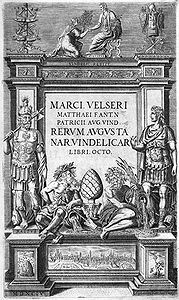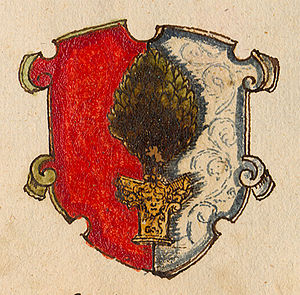
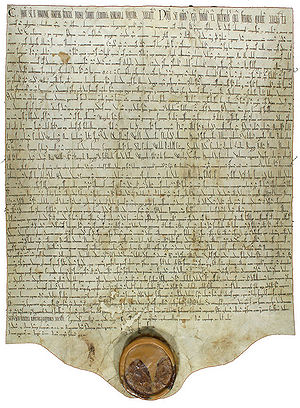
The roots of the imperial city (Reichsstadt) of Augsburg lay in the High Middle Ages of the 12th and 13th centuries. Augsburg underwent a historical process of constitutional development which can be approximately described by the historical city types of episcopal city – royal city – imperial city. These transitions were fluid and integrated into a complicated network of power both in- and outside the city. At times one of the largest cities in the empire, the Thirty Years' War marked a turning point in the city's history, which was not least reflected in a (more than) halving of its population. The year 1648 brought a peculiarity in terms of imperial law: until the end of the Old Empire, Augsburg was an imperial city with equal representation, whose complex system of offices was denominationally staffed by one Protestant and one Catholic minister each. The mediatisation on 4 March 1806 marked the end of the development of the imperial city. With it, Augsburg fell to the Kingdom of Bavaria.
Lines of development in the imperial city (Reichsstadt)
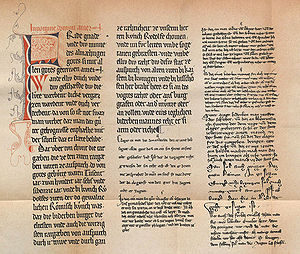
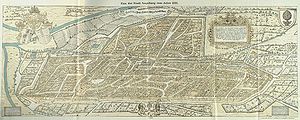
Augsburg is one of the oldest cities in Germany and experienced its first historical heyday in the Roman Empire (1st century BC-3rd century AD). Situated on a high terrace of the rivers Lech and Wertach, the town rose to become the capital of the province of Raetia Secunda. Based on archaeological finds, there is proof for a continuity of settlement between late antiquity and early medieval times. Throughout the course of the Middle Ages, the city was able to to almost continuously expand its importance, especially for the central authorities. Augsburgs attainment of being directly subordinate to the Holy Roman emperor alone was a centuries-long development process determined by several factors and actors. The Ottonian-Salian city was under the rule of the bishop, but the king increased the influence of the central power on the city in the High Middle Ages, f. e. through his presence. In 1156 Friedrich I Barbarossa (ruled 1152-1190, emperor from 1155) granted a privilege of town rights, which refers back to an older "Weistum" (historical legal text) of 1104, and opened up a considerable scope for the further development of the citizenship by establishing the rights of bishop, burgrave and prince-bishopric bailiff. Barbarossa severely curtailed the bishop's rights by taking over the prince-bishopric bailiwick in 1176. The first citizens‘ seal is documented in 1237. Over the course of the 13th century, the citizens succeeded in peeling some rights away from the bishop (f. e. right of taxation, military sovereignty, consumption tax, customs duties, protection of Jews). Following a call to pay the imperial tax in 1231 and the city’s designation as "urbs regia", the royal privileges of Rudolf of Habsburg (ruled 1273–1291) from 1276 (city book) and Adolf of Nassau (ruled 1292–1298) from 1294 paved the way for the city’s autonomy through the rights of statute granted within, such as the "ius de non evocando" (citizens could only be brought before the municipal courts). During this time, the Council asserted itself more and more as the decision-making body. In 1316, King Ludwig IV der Bayer (ruled 1314-1347, emperor from 1328) determined the inalienability of the city from the empire (confirmed 1358). The privilege granted by Sigismund (ruled 1411-1437, emperor from 1433) to elect the city bailiff in 1426 brought the process of making Augsburg immediately subordinate to the emperor to a conclusion.
Despite episcopal attempts to take over the city government, especially in the 15th century, this immediate subordination remained, and the bishop's rule was largely limited to an area around the cathedral. With the head of the empire's presence in the city varying, the immediate status manifested itself in financial (minting of coins, but also taxes, registry contributions) and judicial terms (appeals to the central power in response to quite a few external threats throughout history, such as the late medieval conflict with the nearby Wittelsbach territories) as well as in the area of administration and representation of the community. Participation in the empire was manifested in the city’s status as an imperial estate (Reichsstand), a status that enabled its delegates to attend the Council of Cities (Städtetag) which was formalized as an imperial collegium (reichsständisches Kollegium) in 1489. Merely provided with the right to consult from 1547 onwards, the imperial cities and hence also the imperial city of Augsburg only had the opportunity to intervene in the empire's decision-making processes after the Peace of Westphalia in 1648. On the other hand, the king's rule of the city brought with it numerable central governmental interventions in the city's constitutional structure. This was most powerfully expressed in 1548 by the "Carolinische Regimentsordnung", in which Emperor Karl V (ruled 1519-1556, emperor from 1530) decreed a new constitution for the imperial city, which was carried out under patrician and Catholic auspices and strengthened the possibilities of intervention by the central authorities (revisions and additions in 1719 and 1740). The "royal element" was also evident in inner-city conflicts, which were investigated by corresponding commissions. Augsburg became part of Bavaria through mediatisation on 4 March 1806 and lost its status as an imperial city as a result.
Population figures
As in many cities, due to the sources only approximations of pre-modern demography are possible. Estimates for the imperial city of Augsburg's heyday around 1500 fluctuate between 30,000 and 50,000 inhabitants. Only from the later 16th century onwards are largely reliable statements possible, as the "population registers", which are preserved until the middle of the 18th century, begin to appear and provide a largely secure basis based on births, deaths and marriages. An important addition to the registers is the collection of tax books. It is usually assumed that Augsburg had about 30,000 inhabitants around 1500 and that the population had increased by another 10,000 by the time of the Thirty Years' War. A major demographic turning point has to be placed in the turmoil of the first half of the 17th century. After a large plague epidemic with about 9,000 deaths (1628), a census in 1635 showed a population of 16,432 (12,017 Protestant and 4,415 Catholic). Contemporaries estimated the population of Augsburg at the end of the Old Empire to be at 34,000-38,000. The denominational share shifted in the course of the following century and a half, and so a census from 1809 showed 11,534 Protestants, 16,944 Catholics and 634 Jews.
City of Hoftag assemblies and Imperial Diets (Hof- und Reichstage)
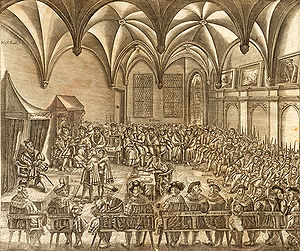
The importance of Augsburg for the central power from the time of Charlemagne (ruled 768-814, emperor from 800) onwards is demonstrated by a total of 109 royal residencies from 787 to 1267, many of which can be categorised as Imperial Diets (Hoftag) assemblies. That importance stemmed not only from existing infrastructure but also from its strategically important location, not least as a meeting point for expeditions to Italy. In an Italian source (Rolandinus of Padua, died 1276), Augsburg was described in 1235 as the actual city of the Emperor in "Germany" ("civitas scilicet imperatoris in Alemannia et semper imperii propria mansio"). Whether the presence of the central power in the Early and High Middle Ages also had a greater constructional impact within the city (as a royal palace) is disputed and overall rather unlikely. The presence of the king and the empire reached its peak in the 15th and especially in the 16th century, correlating with the imperial city's economic boom years. Maximilian I (ruled 1486/1493–1519, emperor from 1508) increased the royal reference which had been established by his father Friedrich III (ruled 1440-1493, emperor from 1452) and owned his own house in the imperial city. 12 of the 16th century Imperial Diets were held in Augsburg, including the particularly historically relevant ones of 1518 with the interrogation of Martin Luther (1483-1546), 1530 ("Confessio Augustana"), 1548 ("Geharnischter Reichstag") and 1555 ("Augsburger Religionsfrieden"), which put Augsburg in the ranks of the most important Reformation sites. After the successful "parish reformations (“Gemeindereformationen”)" (Rolf Kießling) ), the long hesitant Augsburg Council finally felt compelled in 1534 to seize religious sovereignty, and even banned the Catholic rite in 1537.
The city’s imperial diet history ended in 1582. The reasons why the "steps" of (institutionalised) imperial history increasingly moved away from Augsburg are multi-causal, but lie not least in the Reichstags ties to Regensburg, beginning in 1594. Embedded between the Habsburg spheres of power in the west and the Wittelsbach spheres of power in the east, Augsburg's geostrategic position led to a political ambivalence which avoided joining larger alliances (or only doing so late). This attitude was probably an even more fundamental feature of imperial city politics than in comparable communities.
The city with equal representation
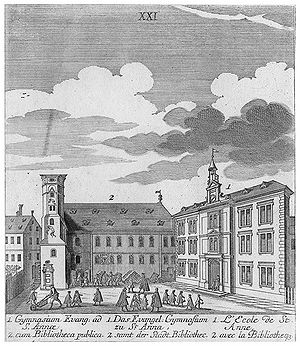
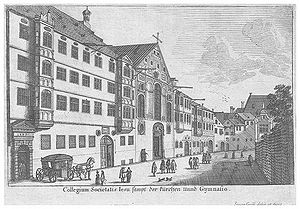
In the 18th century, enlightened contemporaries ridiculed the – pertaining to imperial law – peculiar feature of parity, which Augsburg had in common with Biberach, Ravensburg (both in Baden-Württemberg) and Dinkelsbühl (Ansbach district). This denominational equality in religious as well as political terms and regardless of the demographic majority was stipulated in the 1555 Peace of Augsburg and codified by the Peace of Westphalia in 1648. Specifically, one Protestant and one Catholic representative each occupied the municipal offices. This applied to the hospital and foundation system, but also to the censorship of the rich Augsburg printed matter; the distribution of seats on the authoritative Small Council was specified as well. This parity protected the denominational minority, first the Catholics and, since the first half of the 18th century, the Protestants.
A vigorous confessional clash occurred in the "calendar dispute" of 1582. The calendar, which was improved by Pope Gregory XIII (ruled 1572-1585) because it was adjusted to the position of the sun, met with massive rejection from some Protestants who did not want to grant the Catholic leader "dominion over time". After the dispute, there were almost no more conflicts worth mentioning. Nevertheless, an “invisible border" (Étienne François) ran between the denominations, which was reflected in first names, marriage behaviour, traditional costumes or façade design.
Finally, yet importantly, parity also had an impact on the imperial city's school system: the St. Anna and St. Salvator grammar schools founded in 1531 and 1582 monopolised to a great extent the education of young Protestants and Catholics. In addition, of the parish schools dating back to the Middle Ages, only the cathedral school and the St. Moritz Latin school were able to survive into the 18th century.
Social stratification, social class division and social topography
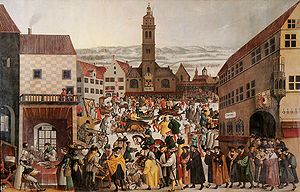
Overall, there is no terminological uniformity in the sources regarding social stratification. The methodology of classification attempts must therefore always be questioned. The early modern imperial city's citizenry can generally be subdivided into "Geschlechter" (families) – "Mehrer" (non-patrician members of the "Herrenstube") – merchants – community. In the 18th century, a change in mentality can be observed in Augsburg and elsewhere, which, in addition to legal aspects, also introduced education levels to categorisation, for example. This also applies to artists who, in the perceptions of the outgoing Old Empire, inserted themselves in parts as a new estate between the community and the merchants. The lowest strata of the population was divided into citizens (who were subject to city law and were supported by the community) and those on the periphery. Attempts to divide the population into lower and upper classes (with their respective subdivisions) are also subject to a certain degree of arbitrariness due to the division being linked to the respective financial circumstances. With taxable assets of up to 99 fl., in the 15th century over three quarters of the citizens continuously belonged to the so-defined lower class, while in 1492 a good 80% of the total assets were in the hands of 5% of the citizens. Around 1610, just under 40% were said to be completely destitute and 7.5% rich or "steinreich". The sources also clearly show a social topography from the 17th century onwards: fortune accumulated in the upper town; the Lechviertel and Jakobervorstadt were, with exceptions, rather poor.
Economic history , which can only be outlined here, was closely related to social development. As an imperial city involved in the structures and policies of local and long-distance trade, Augsburg was massively subject to the effects of the commercial situation. The heyday of Augsburg's trade from 1500 onwards led to a population growth which was only reached again in the 19th century. However, even back then the social gap was huge, not least because of the dominance of the sensitive textile industry. From the 16th century onwards, it had to ward off competition from central Germany, but also from England and the Netherlands. The Thirty Years' War also marks a turning point here. The population decreased by about 60%, the number of weavers even by four fifths. After 1648, an economic upswing set in again, which was not least linked to textiles, arts and crafts and goldsmithing. In 1738 the imperial city counted about 275 master goldsmiths whose products were of European importance and were delivered to the great courts of the time. The arts and crafts were also able to establish a good reputation during the 17th and 18th centuries; for example, contemporaries in the late 18th century spoke of "Augsburger Geschmack" (Augsburg taste) to classify a rococo style.
Patriciate
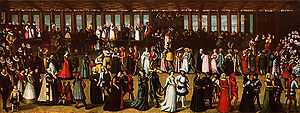
The term “patriciate” describing a political-social urban ruling class is a modern concept of understanding. Referred to in the High and Late Middle Ages as "viri potiores", "herren", "burger des rats" or generally as "Geschlechter", the term "patricians" can be traced back to the 16th century for Augsburg. After its beginnings in the Hohenstaufen period of ministeriality, the economic component increasingly became a focus from the 13th century onwards. This group grew in the following century, not least due to influx, before a council statute of 1383 restricted this "open system" by birth status. Despite marriages and rare new admissions, the patriciate was reduced to a few families. 38 other families were therefore admitted in 1538 – the most famous example being the Fugger family. After winning the Schmalkaldic War (1546-1547), Emperor Karl V strengthened the power of the patriciate, which on the other hand also meant an expansion in its numbers through mandates from the central power. The last induction happened in 1802.
Guild system and political claim
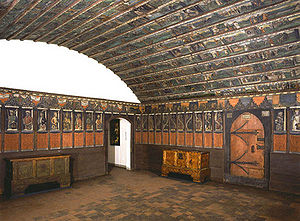
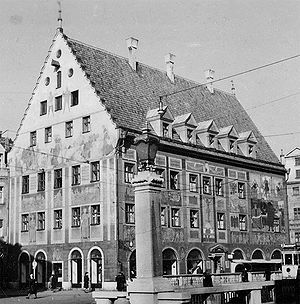
The guilds (Zünfte), as commercial cooperatives fighting for participation in the city government, distinguished themselves in particular through the guild uprising in 1368. Whereas previously there had been cooperations between artisans with a certain internal organisation, the spokesmen of the "insurgents", who had administrative and political experience, now demanded fundamental changes in the tax code and city constitution. The "Second Guild Charter" (16.12.1368) affixed the distribution of the council seats and municipal offices between the patriciate and the 18 (from 1397: 17) guilds. This mixed constitution based on compromise lasted until 1548. Inward and outwardly directed structures, some of which were highly complex, intertwined in the guilds. The ”Zunftzwölfer” and guild masters (Zunftmeister), appointed by election of their members, represented the cooperative on the council and in the court, but also made the decisions on the numerous social, commercial, judicial or administrative tasks. Guild membership was a way for aspiring families to exert political influence on the community. The guild compulsion through civil rights and independent trade (later only taxed capital) was an inner-city control mechanism and led to the internal structuring of the imperial city. From the late Middle Ages onwards, this was also expressed edificially, as the economically powerful guilds established domiciles for their cooperation, which were built next to the patrician residences. Purchased in 1389, the weaver's house, bought by the guild which shaped the city's history to the greatest extent, demonstrated the cooperatives claims due to its location near St. Moritz and in the immediate vicinity of the town hall. The two richest guilds in Augsburg – the merchants working in long-distance trade (such as Gossembrot, Welser, Hörbrot, Hoechstetter) and the salt producers, who organised the den trade in salt mainly from Hallein (Austria) and Reichenhall (Bad Reichenhall, Berchtesgadener Land district) – were structured in the "Herrenstube" und "Kaufleutestube" and did not acquire their own guild domicile.
Poor relief in the pre-modern era
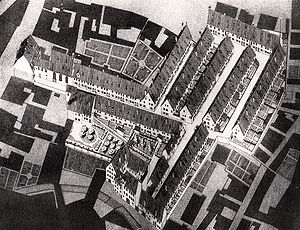
Like Nuremberg, the other large southern German city of the pre-modern era, Augsburg also faced a massive poverty problem. Almsgiving contributions reflect the changing social realities: for example, between 1625 and 1629, around 170% more was spent on this than at the beginning of the beginning of the century. The organisation of poor relief served the administrative pervasion of the community, although the main motivation was undoubtedly the Christian commandment to love one's neighbour and its active confirmation for one's own salvation. While in the High Middle Ages the church had a "monopoly" on care for the poor, the city or the bourgeoisie continuously took its place with their broad foundation system. A dense network of ”Seelhäuser” (for poor widowed or unmarried women), leprosy houses and hospitals, mostly administered by nurses and often built in the late Middle Ages, covered the city as a result. The most famous institution is the Fuggerei, still in effect today, built from 1516 and donated in 1521 to poor, needy "citizens and residents" of Augsburg, with a total of 52 houses each with two residential units – the oldest existing social housing estate in the world.
Further payments in kind and money were centrally controlled by the alms office from the beginning of the 16th century. The assets of the convents secularised during the Reformation went to charity. The six almsmen and their servants tried to get the begging business under control. In 1541, foreign beggars were banished from the city after they had been granted a three-day respite. The new office for the poor and alms was installed in 1711. Although research usually does not give particularly good testimony to the imperial city's poor relief and its social disciplining efforts, they did support the community for centuries. However, contemporaries did indeed criticize the municipal authorities' sometimes rigorous interventions. In the imperial cities' perception, at the end of the Old Empire poverty was a mass phenomenon that could scarcely be controlled, although the weaver's revolts of 1784 and 1794 certainly influenced this assessment. It was only the differing answers to the "social question" which put the care for the poor on a new level in the 19th century.
Historiography as a mirror of imperial cities – historiography as an example of the history of mentalities
The imperial city of Augsburg has a comparatively rich and varied chronicle since the end of the 14th century. The imperial city's consciousness was reflected not least in extensive depictions of the city's "coming of age”, where the beginnings were sought in biblical or mythological times and were also combined with early humanistic approaches in the work of the Benedictine Sigismund Meisterlin (ca. 1435-after 1492.) Historiography differentiated itself along the lines of the institutions the writers belonged to. For example, the councillor Hektor Mülich (1418/1430–1489/1490) was an active writer, as well as the merchant Burkhard Zink (1396–1474/1475), who produced one of the earliest "autobiographical" accounts in the German language. The edition of the Roman inscriptions of the city (1505) by Konrad Peutinger (1465–1547) and the presentation of early history (1594) (1594) by Markus Welser (1558–1614) are historically important sources, showing a humanistic interest in the city's own history. Later works of history reflect the denominational conflicts within the imperial city.
-
Sigismund Meisterlin, Augsburger Chronik, Augsburg 1479-1481. (Bayerische Staatsbibliothek Cgm 213)
-
First page from the chronicles of Hector Mülich (c. 1420-c. 1489). Fig. from: Hektor Mülich, Chronik, Augsburg after 1486. (Staats- und Stadtbibliothek Augsburg (Augsburg State and City Library), 2 ° Cod. Aug. 72)
-
First page of the autobiography of the merchant Burkhard Zink (1396-1474). Here in a copy from the first half of the 16th century. Fig. from: Burkhard Zink, Chronik von Augsburg (1368-1468), Augsburg um 1466, fol. 134. (Edition by Frensdorff, Chroniken, from p. 122)) (Bayerische Staatsbibliothek, Cgm 2028)
-
Title page of the source collection by Konrad Peutinger (1465-1547). Fig. from: Konrad Peutinger, Inscriptiones Vetvstae Roman. Et Earvm Fragmenta In Avgvsta Vindelicorum Et Eivs Diocesi, [Mainz] 1520. (Bayerische Staatsbibliothek, Res/2 Arch. 75#Beibd.1)
-
Title page of the Augsburg Early History (Rerum Augustanarum Vindelicarum libri VIII, Venice 1594) by Markus Welser (1558-1614). (Staatliche Bibliothek Regensburg (Regensburg State Library), 999/Bav.883)
Imperial city archives and sources
Important archival stocks, including the "Secret Archive" with documents passed down from the Middle Ages onwards, were stored in cupboards in the town hall, while other stocks were kept in various rooms. The tradition, decidedly of "imperial city" nature– today's Stadtarchiv Augsburg – begins around 1280 (e.g. Stadtbuch 1276, Missivbücher 1280, Bürgerbuch 1288, unbound files 1290). From the 14th century onwards, a registry system by the offices is also increasingly recorded. All in all, Augsburg's municipal tradition is one of the most important in Germany, as there are often records from the late Middle Ages onwards, e.g. penalty books (from 1273), master builder's bills (from 1320), tax bills (from 1346), council minutes (from 1392), collector's books (from 1462), city court books (from 1480), marriage registries (from 1518) or citizen admission files (from 1548). Some remains of the former imperial city archive cabinets have also been preserved. The rich material has, in sum, only been made accessible selectively and for certain focal points in time (e.g. around 1500, 18th century). In addition to the mentioned city archive holdings, sources from the Staatsarchiv Augsburg, where the tradition of the ecclesiastical institutes is particularly noteworthy, and the manuscripts in the Staats- und Stadtbibliothek Augsburg are of outstanding importance.
References
- Ingrid Bátori, Die Reichsstadt Augsburg im 18. Jahrhundert. Verfassung, Finanzen und Reformversuche (Veröffentlichungen des Max-Planck-Instituts für Geschichte 22), Göttingen 1969.
- Claus Peter Clasen, Armenfürsorge in Augsburg vor dem Dreißigjährigen Krieg, in: Zeitschrift des Historischen Vereins für Schwaben 78 (1984), 65–115.
- Peter Fassl, Konfession, Wirtschaft und Politik. Von der Reichsstadt zur Industriestadt. Augsburg 1750–1850 (Abhandlungen zur Geschichte der Stadt Augsburg 32), Augsburg 1988.
- Étienne François, Die unsichtbare Grenze. Protestanten und Katholiken 1648–1806 (Abhandlungen zur Geschichte der Stadt Augsburg 33), Augsburg 1991.
- Peter Geffcken, Soziale Schichtung in Augsburg 1396–1521. Beitrag zu einer Strukturanalyse Augsburgs im Spätmittelalter, München 1995.
- Gunther Gottlieb u. a. (Hg.), Geschichte der Stadt Augsburg von der Römerzeit bis zur Gegenwart, Stuttgart 1984.
- Klaus Graf, Ordensreform und Literatur in Augsburg während des 15. Jahrhunderts, in: Johannes Janota/Werner Williams-Krapp (Hg.), Literarisches Leben in Augsburg während des 15. Jahrhunderts (Studia Augustana 7), Tübingen 1995, 100-159.
- Günther Grünsteudel u. a. (Hg.), Augsburger Stadtlexikon, Augsburg 2. Auflage 1998. Online-Version bereits aktualisiert.
- Eberhard Isenmann, Die deutsche Stadt im Mittelalter 1150–1550. Stadtgestalt, Recht, Verfassung, Stadtregiment, Kirche, Gesellschaft, Wirtschaft, Köln/Weimar/Wien 2012.
- Claudia Kalesse, Bürger in Augsburg. Studien über Bürgerrecht, Neubürger und Bürger anhand des Augsburger Bürgerbuchs I (1288–1497) (Abhandlungen zur Geschichte der Stadt Augsburg 37), Augsburg 2001.
- Rolf Kießling, Bürgerliche Gesellschaft und Kirche in Augsburg im Spätmittelalter (Abhandlungen zur Geschichte der Stadt Augsburg 19), Augsburg 1971.
- Rolf Kießling, Das Patriziat in Augsburg vom 15. bis ins 17. Jahrhundert, in: Christoph Emmendörffer/Helmut Zäh (Hg.), Bürgermacht und Bürgerpracht. Die Augsburger Prachtcodices in Eton und um Escorial, Luzern 2011, 19–36.
- Christof Paulus, Augsburg, in: Caspar Ehlers u. a. (Hg.), Die deutschen Königspfalzen, 5. Band, 3. Teil: Bayerisch-Schwaben, Göttingen 2016, 1-164.
- Bernd Roeck, Bäcker, Brot und Getreide in Augsburg. Zur Geschichte des Bäckerhandwerks und zur Versorgungspolitik der Reichsstadt im Zeitalter des Dreißigjährigen Krieges (Abhandlungen zur Geschichte der Stadt Augsburg 31), Sigmaringen 1987.
- Bernd Roeck, Eine Stadt in Krieg und Frieden. Studien zur Geschichte der Reichsstadt Augsburg zwischen Kalenderstreit und Parität (Schriftenreihe der Historischen Kommission bei der Bayerischen Akademie der Wissenschaften 37), Göttingen 1989.
- Jörg Rogge, Für den gemeinen Nutzen. Politisches Handeln und Politikverständnis von Rat und Bürgerschaft in Augsburg im Spätmittelalter (Studia Augustana 6), Tübingen 1996.
- Friedrich Roth, Augsburgs Reformationsgeschichte, München 1881–1911 (Bd. 1: 1517-1530, München 2. Aufl. 1901).
- Detlev Schröder, Stadt Augsburg (Historischer Atlas Bayern. Teil Schwaben 10), München 1975.
- Evelien Timpener, Diplomatische Strategien der Reichsstadt Augsburg. Eine Studie zur Bewältigung regionaler Konflikte im 15. Jahrhundert (Städteforschung A 95), Köln/Weimar/Wien 2017.
- Anton Werner, Die örtlichen Stiftungen für die Zwecke des Unterrichts und der Wohltätigkeit in der Stadt Augsburg, Augsburg 1899 (Ergänzungsheft, 1912).
- Wolfgang Wüst, Bettler und Vaganten als Herausforderung für die Staatsraison im Hochstift und der Reichsstadt Augsburg, in: Jahrbuch des Vereins für Augsburger Bistumsgeschichte 21 (1987), 240–279.
- Wolfgang Zorn, Augsburg. Geschichte einer europäischen Stadt, Augsburg 4. Auflage 2001.
Sources
- Michael Cramer-Fürtig (Hg.), Aus 650 Jahren. Ausgewählte Dokumente des Stadtarchivs Augsburg zur Geschichte der Reichsstadt Augsburg 1156-1806, Augsburg 2006.
Further Research
Related Articles
- Augsburg, Bistum/Hochstift: Politische Geschichte (Spätmittelalter)
- Kaufbeuren, Reichsstadt
- Kempten, Reichsstadt
- Lindau, Reichsstadt
- Nördlingen, Reichsstadt
- Nürnberg, Reichsstadt: Politische und soziale Entwicklung
- Ulm, Reichsstadt
- Stadtbuch von Augsburg
Cite
Christof Paulus, Augsburg, Imperial City: Political and Social Development, published 08 December 2017, english version published 22 June 2023, in: Historisches Lexikon Bayerns, URL: <https://www.historisches-lexikon-bayerns.de/Lexikon/EN:Augsburg,_Imperial_City:_Political_and_Social_Development> (20.12.2025)

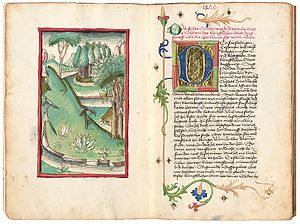
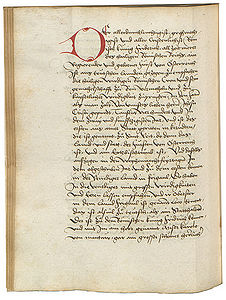
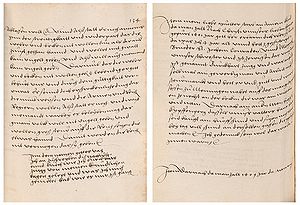
![Title page of the source collection by Konrad Peutinger (1465-1547). Fig. from: Konrad Peutinger, Inscriptiones Vetvstae Roman. Et Earvm Fragmenta In Avgvsta Vindelicorum Et Eivs Diocesi, [Mainz] 1520. (Bayerische Staatsbibliothek, Res/2 Arch. 75#Beibd.1)](/images/thumb/f/f2/Peutinger_Inscriptiones_1520.jpg/217px-Peutinger_Inscriptiones_1520.jpg)
